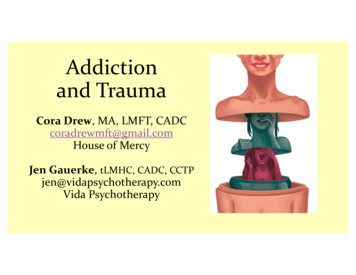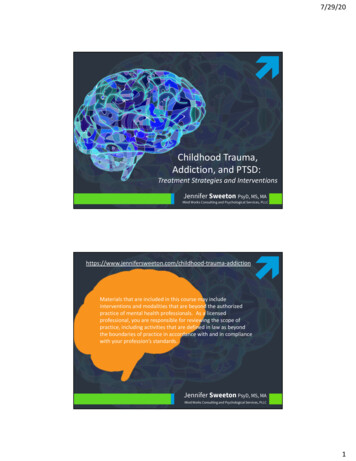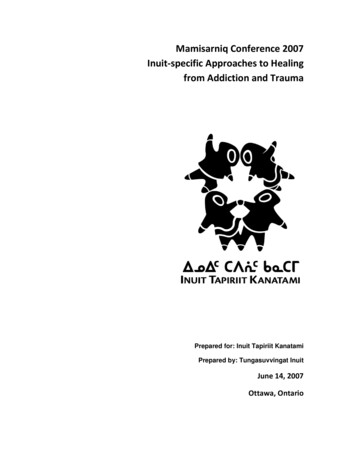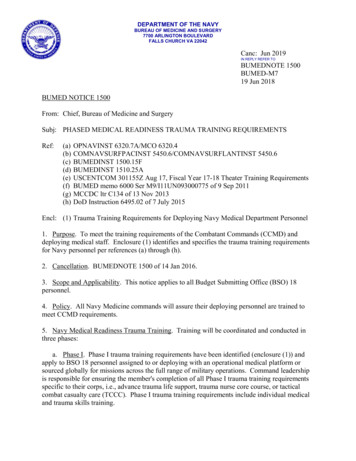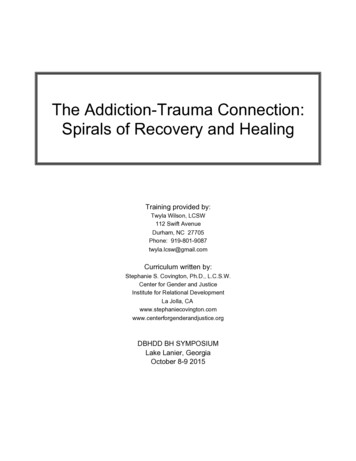
Transcription
The Addiction-Trauma Connection:Spirals of Recovery and HealingTraining provided by:Twyla Wilson, LCSW112 Swift AvenueDurham, NC 27705Phone: 919-801-9087twyla.lcsw@gmail.comCurriculum written by:Stephanie S. Covington, Ph.D., L.C.S.W.Center for Gender and JusticeInstitute for Relational DevelopmentLa Jolla, justice.orgDBHDD BH SYMPOSIUMLake Lanier, GeorgiaOctober 8-9 2015
The Addiction-Trauma Connection:Spirals of Recovery and HealingEvolving Treatment ApproachesThe Addiction-Trauma Connection:Spirals of Recovery and HealingPresented by: Twyla P. Wilson, LCSW, ACSWDurham, NCWritten by: Stephanie S. Covington, Ph.D., L.C.S.W.Center for Gender and JusticeInstitute for Relational DevelopmentLa Jolla, CADBHDD BH SYMPOSIUMLake Lanier, GeorgiaOctober 8-9 2015 S. Covington, Ph.D., 2015 S. Covington, Ph.D., 2015Gender-Responsive TreatmentHistory of Services Creating an environment through: Addiction treatment servicesdesigned for men by men Mental health services designed bymen for women Criminal justice services designedby men for men S. Covington, Ph.D., 2015 that reflects an understanding of the realities ofthe lives of women and girls (men and boys), and addresses and responds to their strengths andchallenges.Source: Covington, S.S., & Bloom, B.E. (2006). Gender-responsive treatment andservices in correctional settings. In E. Leeder (Ed.), Inside and out: Women, prison,and therapy. Binghamton, NY: Haworth.Women’s Issues:An International Perspective Shame and StigmaPhysical and Sexual AbuseRelationship Issues fear of losing children fear of losing a partner needing partner’s permission to obtaintreatment S. Covington, Ph.D., 2015DBHDD BH SYMPOSIUMLake Lanier, GeorgiaOctober 8-9 2015site selectionstaff selectionprogram developmentcontent and material S. Covington, Ph.D., 2015Women’s Issues:An International Perspective Treatment Issues lack of services for women not understanding treatment long waiting lists lack of childcare services Systemic Issues lack of financial resources lack of clean/sober housing poorly coordinated services S. Covington, Ph.D., 20151
The Addiction-Trauma Connection:Spirals of Recovery and HealingEnvironmental TherapyDeeper Psychic ChangeThe ing Trust in othersand in yourself Courage todo new things To like yourselfas a womanThe Future Conflicts Relationships Relapseprevention Workingtogether Socialplanning Trust in others Courage to do new things To like yourself as a woman S. Covington, 2015Lotta Länne, Sweden, 2006 S. Covington, Ph.D., 2015Environmental Therapy (cont.)Guiding Principles forGender-Responsive ServicesCognitive InterventionsManaging Conflicts Relationships Relapse prevention Working together Social planning Gender Environment Relationships Women’s Services Economic & Social Status Community S. Covington, Ph.D., 2015Guiding PrinciplesGuiding Principles Gender: Acknowledge that gender makes adifference. Environment: Create an environmentbased on safety, respect, and dignity. S. Covington, Ph.D., 2015DBHDD BH SYMPOSIUMLake Lanier, GeorgiaOctober 8-9 2015 S. Covington, Ph.D., 2015(cont.) Relationships: Develop policies, practices,and programs that are relational andpromote healthy connections to children,family, significant others, and the community. Services: Address substance abuse,trauma, and mental health issues throughcomprehensive, integrated, and culturallyrelevant services. S. Covington, Ph.D., 20152
The Addiction-Trauma Connection:Spirals of Recovery and HealingGuiding Principles (cont.)Women’s Integrated Treatment( WIT ) Socioeconomic status: Provide women withopportunities to improve their socioeconomicconditions. Community: Establish a system ofcomprehensive and collaborative communityservices.(Bloom, Owen, Covington 2003)This model is holistic, integrated and based on: The gender-responsive definition andguiding principles A theoretical foundation Interventions/strategies that are multidimensional(Covington, 2007) S. Covington, Ph.D., 2015Theoretical Foundation S. Covington, Ph.D., 2015Treatment StrategiesThe theories related to gender andsubstance abuse (and any otherrelevant treatment services) that createthe framework of thought for programdevelopment.This is the knowledgebase that creates the foundation uponwhich the program is developed.The approaches used in the programthat create the therapeutic process.These are the ways in which theory isoperationalized (how theory isapplied). S. Covington, Ph.D., 2015 S. Covington, Ph.D., 2015Addiction:A Holistic Health Model PhysiologicalProcess of Addiction Emotional Social Spiritual Environmental Political S. Covington, Ph.D., 2015DBHDD BH SYMPOSIUMLake Lanier, GeorgiaOctober 8-9 2015 S. Covington, Ph.D., 20153
The Addiction-Trauma Connection:Spirals of Recovery and HealingADDICTION AS A NEGLECTOF SELFAddiction as a Relationship A chronic neglect of self in favor ofsomeone or something else Codependency – having one’s life revolvearound another person’s addiction ordesiresLove Love-Hate S. Covington, 2015 S. Covington, Ph.D., 2015Upward on:A pediatric-acquired diseaseRecovery(expansion) S. Covington, Ph.D., 2015Adolescence & Alcohol S. Covington, Ph.D., 2015Definition of Recovery Start drinking before age 1447% alcohol dependentThe definition of recovery has shifted from a focuson what is deleted from one’s life (alcohol andother drugs, arrests for criminal acts,hospitalizations) to what is added to one’s life (theachievement of health and happiness). Start drinking after age 219% alcohol dependent(n 43,000)(Source: Archives of Pediatrics & Adolescent Medicine, July 2006)(Miller & Kurtz, 2005) S. Covington, Ph.D., 2015DBHDD BH SYMPOSIUMLake Lanier, GeorgiaOctober 8-9 2015 S. Covington, Ph.D., 20154
The Addiction-Trauma Connection:Spirals of Recovery and HealingWomen in Recovery:Understanding AddictionAlcohol and other Drug Education S. Covington, Ph.D., 2015 S. Covington, Ph.D., 2015Women’s PsychologicalDevelopment S. Covington, Ph.D., 2015THE RELATIONAL MODEL OF WOMEN’SPSYCHOLOGICAL DEVELOPMENT Developed by theorists at The Stone Center (Miller,Jordan, Surrey) Women’s primary motivation throughout life is theestablishment of a strong sense of connection withothers Separation and individuation are not seen as the primarygoals of women’s psychological development Females develop their sense of self and self-worth whentheir actions arise out of connections with others Mutuality, respect and empathy are fundamental aspectsof healthy, growth producing relationships Mutual empowerment: power with, not power over S. Covington, Ph.D., 2015DBHDD BH SYMPOSIUMLake Lanier, GeorgiaOctober 8-9 2015 S. Covington, Ph.D., 2015Relationships with Others Women are the “carriers” of relationship in thissociety Repeated disconnections have significantpsychological consequences They are much more likely to be motivated byrelational concerns than men Women cite relational pain, attempts to beconnected as reasons for AOD use Women alter themselves to fit the relationshipsavailable to them S. Covington, Ph.D., 20155
The Addiction-Trauma Connection:Spirals of Recovery and HealingRelational-Cultural TheoryRelational-Cultural TheorySome women use drugs: Connection and development To maintain a relationship Disconnection To fill in the void of what’s missing ina relationship Sociocultural disconnection Privilege and domination To self-medicate the pain of abuse inrelationships(Covington & Surrey, 1997) S. Covington, Ph.D., 2015 S. Covington, Ph.D., 2015Crisis Danger & Opportunity S. Covington, Ph.D., 2015StatisticsLevels of Violence S. Covington, Ph.D., 2015ChildhoodAdolescenceAdultStreet (workplace and community)Consumer CultureMediaWarPlanetThe following statistics illustrate howpervasive interpersonal violence is in thelives of women and girls. A woman is battered every 15-18 seconds (United NationsCommission on the Status of Women, 2000). Approximately 1.5 million women are raped or physicallyassaulted by an intimate partner each year in theUS. Women under 24 years of age suffer the highest rates ofrape (NOW, 2010). There is one sexual assault every about every two minutes.(FBI CIUS, 2008). S. Covington, Ph.D., 2015 S. Covington, Ph.D., 2015DBHDD BH SYMPOSIUMLake Lanier, GeorgiaOctober 8-9 20156
The Addiction-Trauma Connection:Spirals of Recovery and HealingStatisticsStatistics 1 in 6 women will be sexually assaulted in her lifetime,with college age women 4 times more likely to besexually assaulted (RAINN, 2007). More than half of rapes occur before age 18 and 22%occur before age 12 (CDC, 2009b). Children from violent homes have a higher tendency tocommit suicide, abuse drugs and/or alcohol, and commitviolence against their own partners and children(Whitfield, Anda, Dube, and Felitti, 2003). 1 in 5 girls and 1 in 10 boys are sexually victimizedbefore adulthood (Nat’l Center for Missing and ExploitedChildren, 2008). More than 30 million children in the U.S. live in lowincome families, and 14 million children live in poverty(Wight, Chau, and Aratani, 2010). In homes where DV occurs, children are seriouslyabused or neglected at a rate that is 1,500% higher thanthe national average for the general population(Children’s Defense Fund Ohio, 2009). Children born into poverty risk exposure to violence thatis so high they are guaranteed to be affected by trauma(Women’s Law Project, 2002). S. Covington, Ph.D., 2015 S. Covington, Ph.D., 2015Statistics If a victim of domestic violence, a woman is 80% morelikely to have a stroke, 70% more likely to drink heavilyor to have a heart attack, 60% more likely to haveasthma (FVPF, 2009d).Although the world is full of suffering,it is also full of the overcoming of it.-Helen Keller While relationship violence happens to women ofevery race and ethnic background, African-Americanwomen are physically assaulted at a rate that is 35%higher than Caucasian women, and about 2-1/2 timesthe rate of women of other races. (National CoalitionAgainst Domestic Violence, 2000). S. Covington, Ph.D., 2015Violence Against WomenViolence against women is so pervasive thatthe United Nations has addressed and definedviolence against women as “any act of genderbased violence that results in, or is likely to resultin, physical, sexual or psychological harm orsuffering to women, including threats of such acts,coercion or arbitrary deprivations of liberty,whether occurring in public or private life.” S. Covington, Ph.D., 2015Moral Challenges 19th century – slavery 20th century – totalitarianism 21st century – brutality againstwomen and girls(NY Times 9/23/09)(United Nations General Assembly, 1993). S. Covington, Ph.D., 2015DBHDD BH SYMPOSIUMLake Lanier, GeorgiaOctober 8-9 2015 S. Covington, Ph.D., 20157
The Addiction-Trauma Connection:Spirals of Recovery and HealingDefinition of Trauma (cont.)Definition of Trauma The exposure must result from one or more ofThe diagnostic manual used by mental healthproviders defines trauma as:the following scenarios in which the individual: directly experiences the traumatic event; witnesses the traumatic event in person;a) exposure to actual or threatened death,serious injury or sexual violation.(American Psychiatric Assoc. [APA] DSM-5) learns that the traumatic event occurred to a close family member or close friend; experiences first-hand repeated or extremeexposure to aversive details of the traumaticevent (not through media, pictures, television ormovies unless work-related). (American Psychiatric Assoc. [APA] DSM-5 S. Covington, Ph.D., 2015 S. Covington, 2015)Definition of Trauma (cont.) The disturbance, regardless of its trigger,causes significant distress or impairment inthe individual’s social interactions, capacityto work, or other important areas offunctioning.(It is not the physiological result of another medicalcondition, medication, drugs or alcohol.)Definition of TraumaTrauma occurs when an external threatoverwhelms a person’s internal andexternal positive coping resources.Source: Van der Kolk, B. (1989).(American Psychiatric Assoc. [APA] DSM-5) S. Covington, Ph.D., 2015 S. Covington, Ph.D., 2015Traumatic EventsTwo Kinds of SufferingTrauma can take many forms: Emotional, sexual or physicalabuse Neglect Abandonment (especially forsmall children) Extremely painful and frighteningmedical procedures Natural Created S. Covington, Ph.D., 2015DBHDD BH SYMPOSIUMLake Lanier, GeorgiaOctober 8-9 2015 S. Covington, Ph.D., 20158
The Addiction-Trauma Connection:Spirals of Recovery and HealingTraumatic EventsTraumatic Events(cont.)(cont.) Catastrophic injuries and illnesses Immigration Rape or assault Natural disasters (hurricanes, floods,earthquakes, tornadoes, fires,volcanoes) Muggings Domestic violence Terrorism such as September 11, 2001 Burglary Witnessing violence such as a parentharming another parent Automobile accidents S. Covington, Ph.D., 2015Traumatic Events (cont.) S. Covington, Ph.D., 2015Historical Trauma Loss of a loved one and severebereavements (even of a pet) Across generations Combat/war Massive group trauma Torture Examples include: Native Americans,African Americans, Holocaustsurvivors, Japanese internmentsurvivors, Aboriginal (First Nation) Victim of trafficking Kidnapping Intergenerational (cultural) trauma S. Covington, Ph.D., 2015 S. Covington, Ph.D., 2015Traumatic EventsTrauma and AbuseIntimate Partner ViolenceStigmatizationWomen and girls in criminal justice systemWomen and girls of colorWomen and girls in povertyLesbian, gay, bisexual, transgenderedWomen and girls with mental illness S. Covington, 2015DBHDD BH SYMPOSIUMLake Lanier, GeorgiaOctober 8-9 2015Of all these forms of trauma,women are at greater risk of intimatepartner violence than men. S. Covington, Ph.D., 20159
The Addiction-Trauma Connection:Spirals of Recovery and HealingGender and AbuseTrauma As children, boys and girls suffer similar rates of abuse Girls - sexually abused Boys - emotional neglect or physical abuse. In adolescence, boys are at greater risk if they are gay,young men of color, or gang members. Young men - people who dislike or hate them. Young women – relationships; from the person towhom she is saying, “I love you.” Adulthood Man - combat or being a victim of crime Woman – relationship; the person “I love you.”Gender Differences S. Covington, Ph.D., 2015 S. Covington, Ph.D., 2015Process of TraumaPost-TraumaticStress DisorderTRAUMATIC EVENTOverwhelms the Physical & Psychological SystemsIntense Fear, Helplessness or HorrorRESPONSE TO TRAUMAFight or Flight, Freeze, Altered State of Consciousness, Body Sensations, Numbing,Hyper-vigilance, Hyper-arousalSENSITIZED NERVOUS SYSTEMCHANGES IN BRAIN Re-experiencing the event through flashbacksand nightmares.CURRENT STRESSReminders of Trauma, Life Events, LifestylePAINFUL EMOTIONAL STATERETREATHARM TO SELFHARM TO NCE ABUSEEATING DISORDERDELIBERATE SELF-HARMSUICIDAL ACTIONSAGGRESSIONVIOLENCERAGESSource: Covington, S., Beyond Trauma: A Healing Journey for Women and Healing Trauma: Strategies for Abused Women CD-Rom . S. Covington, Ph.D., 2015 S. Covington, Ph.D., 2015Post-TraumaticStress Disorder (cont.)Post-TraumaticStress Disorder (cont.) Estrangement (the inability to be emotionallyclose to anyone) Numbing of general responsiveness (feelingnothing most of the time) S. Covington, Ph.D., 2015DBHDD BH SYMPOSIUMLake Lanier, GeorgiaOctober 8-9 2015 Avoidance of stimuli associated with the event(for example, if a woman was raped in a park,she may avoid parks, or if she was assaultedby a blonde man, she may avoid men withblonde hair). Hyper-vigilance (constantly scanning one’senvironment for danger, whether physical oremotional) Exaggerated startle response (a tendency tojump at loud noises or unexpected touch)(DSM – IV) S. Covington, Ph.D., 201510
The Addiction-Trauma Connection:Spirals of Recovery and HealingTrauma-informed Services Take the trauma into account.Core Valuesof Trauma-Informed Care Safety (physical and emotional) Avoid triggering trauma reactions. Adjust organization so that traumasurvivors can access and benefit fromservices. Trustworthiness Choice Collaboration Empowerment(Harris & Fallot)(Fallot & Harris, 2006) S. Covington, Ph.D., 2015 S. Covington, Ph.D., 2015A Culture Shift: Core Values of aTrauma-Informed System of CareBecoming Trauma Informed Safety: Ensuring physical and emotionalsafetyCreates a Culture Shift Trustworthiness: Maximizingtrustworthiness, making tasks clear, andmaintaining appropriate boundaries Choice: Prioritizing consumer choice andcontrol S. Covington, Ph.D., 2015A Culture Shift: Core Valuesof a Trauma-InformedSystem of Care (cont.) Collaboration: Maximizing collaboration andsharing of power with consumers Empowerment: Prioritizing consumerempowerment and skill-buildingSource: Roger Fallot, Ph.D. S. Covington, Ph.D., 2015A Culture Shift: Scope of Change ina Distressed System Involves all aspects of program activities, setting,relationships, and atmosphere (more thanimplementing new services) Involves all groups: administrators, supervisors,direct service staff, support staff, andconsumers (more than service providers)Source: Roger Fallot, Ph.D. S. Covington, Ph.D., 2015DBHDD BH SYMPOSIUMLake Lanier, GeorgiaOctober 8-9 2015 S. Covington, Ph.D., 201511
The Addiction-Trauma Connection:Spirals of Recovery and HealingA Culture Shift: Scope of Change ina Distressed System (cont.) Involves making trauma-informed change into anew routine, a new way of thinking and acting(more than new information)Source: Roger Fallot, Ph.D. S. Covington, Ph.D., 2015The Adverse Childhood Experiences(ACE) Study Collaboration betweenA Culture Shift:Changes in Understanding and Practice Thinking differently as a prelude toacting differently Thinking differently initiates andsustains changes in practice and setting Acting differently reinforces and clarifieschanges in understandingSource: Roger Fallot, Ph.D. S. Covington, Ph.D., 2015ACE Study(Adverse Childhood Experiences)Before age 18: Centers for Disease Control andPrevention (CDC) Recurrent and severe emotional abuse Kaiser Permanente HMO in California Recurrent and severe physical abuse Contact sexual abuse Largest study ever Physical neglect 17,000 adult members participated Emotional neglect S. Covington, 2015ACE StudyACE Study(Adverse Childhood Experiences)(Adverse Childhood Experiences)Results:Growing up in a household with:ACEs still have a profound effect 50 yearslater, although now transformed frompsychosocial experience into organic disease,social malfunction, and mental illness. An alcoholic or drug-user A member being imprisoned A mentally ill, chronically depressed, orinstitutionalized member The mother being treated violently Both biological parents not being present(N 17,000) SmokingAlcoholismInjection of illegal drugsObesity(Felitti, V.J.: Origins of Addictive Behavior: Evidence from the ACE Study. 2003Oct:52(8): 547-59. German. PMID: 14619682 (PubMed-indexed for MEDLINE). S. Covington, Ph.D., 2015DBHDD BH SYMPOSIUMLake Lanier, GeorgiaOctober 8-9 2015 S. Covington, Ph.D., 2015 S. Covington, Ph.D., 201512
The Addiction-Trauma Connection:Spirals of Recovery and HealingHigher ACE ScoreChronic Health Conditions ACE Study (cont.)Heart diseaseAutoimmune diseasesLung cancerPulmonary diseaseLiver diseaseSkeletal fracturesSexually transmitted infectionsHIV/AIDSAddiction Men 16% Sexual Abuse Men 30% Physical Abuse Women 27% Sexual Abuse(Felitti and Anda, 2010) S. Covington, Ph.D., 2015 S. Covington, 2015ACE Study (cont.)ACE Study (cont.)Population Studied:Women are 50% more likely than mento have a score of 5 or more. 80% white 74% college (36% some) 18% high school grads(Felitti & Anda, 2010)(Felitti & Anda, 2010) S. Covington, Ph.D., 2015ACE Study (cont.) S. Covington, Ph.D., 2015ACE Study (cont.)If a male child has 6 or more “yes” answers,his risk of becoming an IV drug userincreases by 4,600% compared to a boywith a score of zero.One-third of the grouphad a score of 0.(Felitti & Anda, 2010) S. Covington, Ph.D., 2015DBHDD BH SYMPOSIUMLake Lanier, GeorgiaOctober 8-9 2015 S. Covington, Ph.D., 201513
The Addiction-Trauma Connection:Spirals of Recovery and HealingAdverse Childhood ExperiencesFive-State Study 2010 Collaboration between CDC and statehealth departments of AR, LA, NM,TN and WA. 26,229 adults were surveyedACE Scores and ImpactAdverse childhood experiences areunderlying factors for: Chronic depression Suicide attempts Serious and persistent mental healthchallenges Addictions Victimization of rape and domesticviolenceSource: Ann Jennings, Ph.D. S. Covington, Ph.D., 2015 S. Covington, Ph.D., 2015Adverse Childhood CE Study (cont.)“I see that you have Tell me how that has affected youlater in your life.”(Felitti & Anda, 2010)R. Fallot, Ph.D. S. Covington, Ph.D., 2015 S. Covington, Ph.D., 2015Women in PrisonWomen in Prison (cont.)Largest Effect-Mental HealthLargest Effect-Mental Health Psychotropic medication 980% increase in odds if exposedto 7 CTE’s Mental health treatment Attempted suicide(Messina & Grella, 2005) Traumatic stress(Messina & Grella, 2005) S. Covington, Ph.D., 2015DBHDD BH SYMPOSIUMLake Lanier, GeorgiaOctober 8-9 2015 S. Covington, Ph.D., 201514
The Addiction-Trauma Connection:Spirals of Recovery and HealingAdverse Childhood ExperiencesAdverse Childhood ExperiencesThe relationship between ACE Score andthe likelihood of 50 sexual partners.The relationship between ACE Score and teenagesexual behavior and promiscuity.(Felitti & Anda, 2010) S. Covington, 2015ACE Study(Felitti & Anda, 2010) S. Covington, 2015Washington High School (cont.)Walla Walla, WAwww. ACEStooHigh.com2009 – 2010 (Before new approach) 798 suspensions 50 expulsions 600 written referrals Wow. Are you okay? What’s going on?2010 – 2011 (After new approach) 1 – 10 with anger 135 suspensions 30 expulsions 320 written referrals S. Covington, Ph.D., 2015Critical and Interrelated Issues Substance Abuse S. Covington, Ph.D., 2015Changes in Understanding:The Centrality of TraumaIncarceration Mental Health TraumaViolence andTrauma Physical HealthSubstanceAbuse Crime S. Covington, Ph.D., 2015DBHDD BH SYMPOSIUMLake Lanier, GeorgiaOctober 8-9 2015HomelessnessMental HealthProblems S. Covington, Ph.D., 201515
The Addiction-Trauma Connection:Spirals of Recovery and HealingLevel of BurdenSubstanceAbuseMentalIllness“Burden” defined as the total number ofproblem ssness S. Covington, 2015Source: Vivian Brown, Ph.D.Key Elements Use of alcohol and/or other drugsHomelessCo-occurring mental health problemSignificant health disorderHIV/AIDSCognitive impairmentHistory of childhood or adult abuseSource: Vivian Brown, Ph.D. S. Covington, 2015Secondary Traumatic Stress (STS)(Staff and Clients)Compassion fatigue: No empathy – doesn’t happen Charles Figley “sudden” Learn what trauma/abuse is Understand typical responsesBurnout: Bloom – conflict of values Develop coping skillsVicarious traumatization: Laurie Pearlman “slow” S. Covington, Ph.D., 2015The Longest Waris the One Against Women S. Covington, Ph.D., 2015The Longest Waris the One Against Women (cont.)By Rebecca 10Published on Thursday, January 24, 2013 by TomDispatch.com Rape Mass murder Homicides S. Covington, Ph.D., 2015DBHDD BH SYMPOSIUMLake Lanier, GeorgiaOctober 8-9 2015R. Solnit, 2013 S. Covington, Ph.D., 201516
The Addiction-Trauma Connection:Spirals of Recovery and HealingThe Longest Waris the One Against Women (cont.)Homicide 1976-2005 88.8% men 11.2% womenHomicide (guns) 91.3% men 8.7% womenHomicide (multiple victims) 93.5% men 6.5% womenR. Solnit, 2013The Longest Waris the One Against Women (cont.) Most perpetrators of violence are men Doesn’t mean all men are violent Men also suffer violence, largely at thehands of other men S. Covington, Ph.D., 2015The Longest Waris the One Against Women (cont.)R. Solnit, 2013 S. Covington, Ph.D., 2015America Has an Incest Problem(January 2013)Child sexual abuse impacts morePandemic of violence by menagainst women, both intimate andAmericans annually than cancer, AIDS, gunviolence, LGBT inequality, and thestranger violencemortgage crisis combined.R. Solnit, 2013 S. Covington, Ph.D., 2015“What I have concluded from decadesof working with every kind of violentcriminal is that the way to proveone’s manhood to gain respect isto commit a violent act.”- James Gilligan S. Covington, Ph.D., 2015DBHDD BH SYMPOSIUMLake Lanier, GeorgiaOctober 8-9 2015Fontaine, January 2013. “America Has an Incest Problem”. The Atlantic. S. Covington, Ph.D., 2015Prevalence of Trauma and PTSD inSubstance Use/Abuse 60% to 90% of a treatment-seeking sampleof substance abusers also have a history ofvictimization More than 80% of women seekingtreatment for a substance use disorderreported experiencing physical/sexualabuse during their lifetime S. Covington, Ph.D., 201517
The Addiction-Trauma Connection:Spirals of Recovery and HealingHistories of Trauma/Violenceamong Clients Treated forMethamphetaminePrevalence of Trauma and PTSD inSubstance Use/Abuse (cont.) Between 44% and 56% of women seekingtreatment for a substance use disorder hada lifetime history of PTSDPersons in treatment for methamphetaminereport high rates of trauma: 85% women 69% men 10.3% of the men and 26.2% of the womenwith a lifetime diagnosis of alcoholdependence also had a history of PTSD S. Covington, Ph.D., 2015 S. Covington, Ph.D., 2015Histories of Trauma/Violenceamong Clients Treated forMethamphetamineHistories of Trauma/Violenceamong Clients Treated forMethamphetamineMost common source of trauma/violence:History of sexual abuse: For women, was a partner (80%) For men, was a stranger (43%) 57% women 16% men S. Covington, Ph.D., 2015Prevalence of Trauma and PTSDin Severe Mental Illness 98% reported exposure to at least one traumaticevent, lifetime 43% of sample received a current diagnosis ofPTSD; only 2% had PTSD diagnosis in theircharts Severely mentally ill patients who were exposedto traumatic events tended to have been multiplytraumatized, with exposure to an average of 3.5different types of trauma. S. Covington, Ph.D., 2015DBHDD BH SYMPOSIUMLake Lanier, GeorgiaOctober 8-9 2015 S. Covington, Ph.D., 2015Disorders Related to Trauma andSubstance Abuse in Women’s Lives Depressive Disorders NOSMajor Depressive DisordersPost traumatic Stress DisordersNeurotic Anxiety DisordersBipolar DisordersMood or Dysthymic DisordersPsychotic DisordersPersonality and Misc. ce: Patterns of Comorbidity among Women with Childhood Interpersonal Trauma, MentalHealth Disorders, and Substance Related Disorders. Journal of Behavioral Health Services &Research (in press) S. Covington, Ph.D., 201518
The Addiction-Trauma Connection:Spirals of Recovery and HealingAmerica Has an Incest ProblemAmerica Has an Incest Problem(January 2013)(January 2013)Sexually abused youth are:95% of teen prostitutes andat least 35% of female prisonerswere abused as kids. Twice as likely to be arrested for a violenceoffense as adults Twice the risk for lifelong mental health issues Twice as likely to attempt or commit teen suicideFontaine, January 2013. “America Has an Incest Problem”. The Atlantic. S. Covington, Ph.D., 2015America Has an Incest Problem(January 2013)Fontaine, January 2013. “America Has an Incest Problem”. The Atlantic. S. Covington, Ph.D., 2015Helping Women RecoverHelping Men Recover(two versions)Incest is the single biggest commonalitybetween drug and alcohol addiction, mental Community Criminal Justiceillness, teenage and adult prostitution,criminal activity, and eating disorders.Fontaine, January 2013. “America Has an Incest Problem”. The Atlantic. S. Covington, 2015 S. Covington, Ph.D., 2015Helping Women Recover:A Program for Treating AddictionGender-responsiveTheory of Addiction Female socialization Holistic health model Chronic neglect of self in favor of somethingor someone else Male socializationTheory of Women’s Psychological Development Relational–Cultural Theory (Stone Center)Theory of Trauma Three Stage Model (Herman) Upward Spiral – A Transformational Model (Covington) S. Covington, Ph.D., 2015DBHDD BH SYMPOSIUMLake Lanier, GeorgiaOctober 8-9 2015 S. Covington, Ph.D., 201519
The Addiction-Trauma Connection:Spirals of Recovery and HealingHelping Men Recover:Voices:A Program for Treating AddictionA Program of Self-Discovery andEmpowerment for Girls(Covington, Griffin & Dauer)Theory of Addiction Holistic health model Chronic neglect of self in favor of something orsomeone elseTheory of Men’s Psychological Development Relational–Cultural Theory (Stone Center) Kivel, Pollack, etc.Theory of Trauma Three Stage Model (Herman) Upward Spiral – A Transformational Model (Covington) S. Covington, Ph.D., 2015 S. Covington, 2015Gender-responsive MaterialsVoices: A Program of Self-discovery and(trauma-informed)Empowerment for GirlsTheory of Girls’ Psychological Development Relational-Cultural Theory (Stone Center, Gilligan, Brown)Theory of Attachment Ainsworth, Bowlby, Harlow, Stern Women in RecoveryA Woman’s Way through The Twelve StepsVoices:A Program of Self-Discovery and Empowermentfor GirlsTheory of Trauma Three Stage Model (Herman) Transformational Spiral (Covington) Theory of ResilienceBecoming Trauma Informed:A Training Curriculum for CorrectionalProfessi
The Addiction-Trauma Connection Spirals of Recovery and Healing Training provided by: Twyla Wilson, LCSW 112 Swift Avenue Durham, NC 27705 Phone: 919-801-9087 twyla.lcsw@gmail.com Curriculum written by: Stephanie S. Covington, Ph.D., L.C.S.W Center for Gender and Justice Institute for Relational Developmen La Jolla, CA www.stephaniecovington.com


